S. Döbert, R. Eichhorn, H. Genz, H.-D. Gräf, R. Hahn, T. Hampel, S. Kostial, H. Loos,
M. Reichenbach, A. Richter, V. Schlott, E. Spamer, A. Stascheck, M. Thomas,
O. Titze, T. Wesp
Institut für Kernphysik, TH- Darmstadt, Schlo ![]() gartenstr. 9,
D-64289 Darmstadt, Germany
gartenstr. 9,
D-64289 Darmstadt, Germany
The S-DALINAC is a recirculating superconducting electron linac operating
at 3 GHz. The accelerator delivers cw-beam to various experiments with
energies from 3 to 120 MeV and currents from 1 nA to 60 ![]() A covering
a wide dynamic range. Since August 1991, some remarkable progress has been
achieved:
A covering
a wide dynamic range. Since August 1991, some remarkable progress has been
achieved:
The unloaded quality factors of the twelve niobium cavities were increased
by chemical treatment, now ranging from 8 ![]() 10
10 ![]() to 2
to 2 ![]() 10
10 ![]() ,
while the accelerating gradients of all cavities exceed 5 MV/m by far.
,
while the accelerating gradients of all cavities exceed 5 MV/m by far.
In 1995, all cavities were equipped with new superconducting input
couplers providing variable coupling strength. In addition, a
superconducting 2-cell capture cavity ( ![]() =0.85) was installed as
the first element of the injector. Beam transport properties of the
main linac were improved by installation of three cold quadrupoles
in the cryostat. All devices operate successfully.
=0.85) was installed as
the first element of the injector. Beam transport properties of the
main linac were improved by installation of three cold quadrupoles
in the cryostat. All devices operate successfully.
Further measures in beam diagnostics were taken. Diagnostic stations for the determination of transverse and longitudinal beam properties, using transition radiation emitted from a thin foil and computer graphics processing, have been developed and are used routinely now. To measure easily even small beam currents without disturbing the beam, rf cavities with low Q have been developed. Using a simple setup, currents down to some nA can be detected.
The S-DALINAC [1] is a superconducting recirculating linear electron
accelerator at Darmstadt, the layout of which is shown in Fig. 1. The
electrons, emitted from a thermionic cathode are electrostatically accelerated
up to 250 keV. In the Chopper/ Prebuncher section (at room temperature) the
continuous electron beam gets its time structure, which is necessary for the
following acceleration in the superconducting S-band cavities. The injector
consists of a 2-cell capture cavity (see below), a 5-cell cavity and
two one meter long 20-cell cavities fabricated from RRR 280 niobium and
operated in liquid helium at 2 K. Within 5 meters, the electrons are
accelerated up to 10 MeV and can either be used for low energy experiments or
bent by 180 ![]() for injection into the main linac. With eigth 20-cell cavities
the energy of the beam can be increased by 40 MeV.
The beam can either be recirculated twice or extracted after each linac passage.
From the first recirculation the beam can be bent and matched to the
undulator of the Free Electron Laser.
for injection into the main linac. With eigth 20-cell cavities
the energy of the beam can be increased by 40 MeV.
The beam can either be recirculated twice or extracted after each linac passage.
From the first recirculation the beam can be bent and matched to the
undulator of the Free Electron Laser.
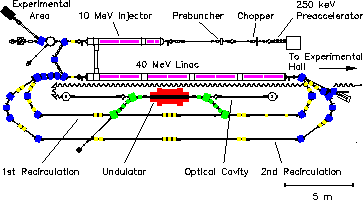
Since August 1991 the S-DALINAC has delivered more than 11.500 hours
of beamtime for a variety of nuclear and radiation physics experiments.
The electron beam produced covers a wide range of energies and
currents to fulfill the different needs. Energies up to 10 MeV
from the injector are used for nuclear resonance flourescence (NRF)
experiments [2], for production of channeling radiation (CR)
[3] and parametric X-rays (PXR) [4].
Beam energies from 22 to 120 MeV were used for high energy channeling
and parametric X-rays as well as for coincident (e,e',x) and
single arm (e,e') electron scattering experiments.
These experiments use a cw beam with a bunch repetition rate of 3 GHz or
10 MHz for time of flight applications.
For driving the Free Electron Laser (FEL) project [5], a bunch charge
of 6 pC is necessary, which is obtained at a repetition rate of 10 MHz,
using a subharmonic chopper/ prebuncher section. The different energies and
currents produced by the S-DALINAC together with the coresponding experiments
are summarized in Tab. 1.
The energy spread of the accelerator is ![]() .
.
In the fall of 1993 two ceramic windows of rf feedthroughs had developed strong
leaks, which caused a degradation of the unloaded quality factor of most of
the cavities to the lower ![]() range. Due to the limited cryogenic
cooling ( about 100 W at 2 K) this limited the achievable energy to
50 MeV even when recirculating the beam twice. Therefore it was necessary
to increase the cavity Q
range. Due to the limited cryogenic
cooling ( about 100 W at 2 K) this limited the achievable energy to
50 MeV even when recirculating the beam twice. Therefore it was necessary
to increase the cavity Q ![]() by chemical polishing of the inner surface of
all cavities. In two maintenance periods all ten 20-cell cavities and
the 5-cell cavity were taken out of the cryostat, chemically treated and
reinstalled.
Two different cleaning methods were applied: With the help of DESY we
were pleased to use the TTF [6] chemistry and clean room infrastructure
for two cavities.
After ultrasonic cleaning, a layer of 1
by chemical polishing of the inner surface of
all cavities. In two maintenance periods all ten 20-cell cavities and
the 5-cell cavity were taken out of the cryostat, chemically treated and
reinstalled.
Two different cleaning methods were applied: With the help of DESY we
were pleased to use the TTF [6] chemistry and clean room infrastructure
for two cavities.
After ultrasonic cleaning, a layer of 1 ![]() thickness of the inner
surface was removed by BCP (1:1:2). The cavities were rinsed with ultra
pure water (18 M
thickness of the inner
surface was removed by BCP (1:1:2). The cavities were rinsed with ultra
pure water (18 M ![]() cm) and dried in a class 10 clean room.
The other cavities were treated in our laboratory. After ultrasonic
cleaning the inner surface was first oxidized by HNO
cm) and dried in a class 10 clean room.
The other cavities were treated in our laboratory. After ultrasonic
cleaning the inner surface was first oxidized by HNO ![]() . then the oxide was
removed by HF. Finally the cavities were rinsed with
ultra pure water and dried with filtered nitrogen.
As a result the unloaded quality factors of all cavities increased by at
least a factor of two, reaching now 8
. then the oxide was
removed by HF. Finally the cavities were rinsed with
ultra pure water and dried with filtered nitrogen.
As a result the unloaded quality factors of all cavities increased by at
least a factor of two, reaching now 8 ![]() to 2
to 2 ![]() , but
still below the design value of 3
, but
still below the design value of 3 ![]() .
The accelerating gradients of all cavities exceed the design gradient of
5 MV/m by far, some cavities reach 10 MV/m after a short processing.
The average gradient of all cavities is presently 6.7 MV/m, while
the mean quality factor is 8.9
.
The accelerating gradients of all cavities exceed the design gradient of
5 MV/m by far, some cavities reach 10 MV/m after a short processing.
The average gradient of all cavities is presently 6.7 MV/m, while
the mean quality factor is 8.9 ![]() . This determines in
conjunction with the limited cryogenic cooling the maximum electron energy
to 120 MeV at present.
. This determines in
conjunction with the limited cryogenic cooling the maximum electron energy
to 120 MeV at present.
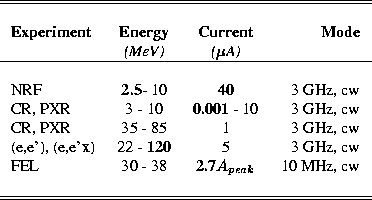
After several warmup and cooldown periods another effect was observed.
While all the cavities were not touched in any sense (not removed from
the cryostat, held under vacuum), some of them show a certain
time dependency of the unloaded quality factor. Directly after cooldown,
some cavities start at a rather low Q ![]() and show field emission at a
certain gradient. After simply operating the cavities at a medium gradient for
15 minutes the Q
and show field emission at a
certain gradient. After simply operating the cavities at a medium gradient for
15 minutes the Q ![]() increases by a factor of 3 and the field emission observed
before vanishes completely.
This effect was observed many times for certain cavities, while other cavities
show no change in the unloaded quality factor
during operation.
increases by a factor of 3 and the field emission observed
before vanishes completely.
This effect was observed many times for certain cavities, while other cavities
show no change in the unloaded quality factor
during operation.
Together with the replacement of the sc cavities, several new components
were installed in the accelerator. All cavities were successively
equipped with new rf input couplers (Fig. 2) providing variable
coupling strength ( ![]() ) by changing the
distance between the antenna and the coaxial resonator. This variability
has proven to be very useful, since it allows an optimum in matching
the different beamloading and microphonic perturbation conditions.
For diagnostic purposes one is able to couple critically.
) by changing the
distance between the antenna and the coaxial resonator. This variability
has proven to be very useful, since it allows an optimum in matching
the different beamloading and microphonic perturbation conditions.
For diagnostic purposes one is able to couple critically.
As the first element of the sc injector a new 2-cell capture cavity has been
installed. The cavity has a reduced phase velocity of ![]() = 0.85
and provides an energy gain of 350 keV over a length of 8.5 cm when operated at
a gradient of 5 MV/m.
= 0.85
and provides an energy gain of 350 keV over a length of 8.5 cm when operated at
a gradient of 5 MV/m.
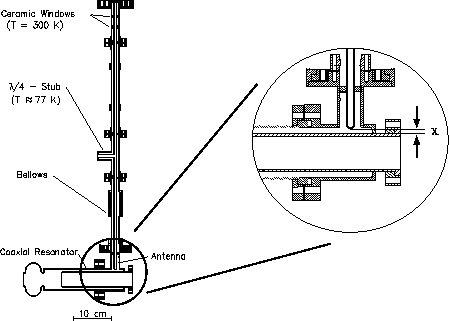
To improve the transverse acceptance of the accelerator four quadrupoles were installed on the main linac axis. One quadrupole is placed outside the cryostat in front of the linac, while the other three quadrupoles had to be installed inside the insulating vacuum of the cryostat. Therefore they where designed to be superconducting, using a NbTi wire (NbTi filament surrounded by Cu) and special low temperature magnetic material called CRYOPERM 10 to form the poles and return chokes. The maximum gradient is 1.5 T/m, the effective length 5.6 cm. After installation it turned out, that the cooling of these quadrupoles is not sufficient (they only reach 22-25 K). Nevertheless, the resistance of the coils becomes low enough to operate them at their nominal gradient with a dissipation of 0.5 W per quadrupole.
Since 1994, several new beam diagnostic stations along the accelerator have been installed. A detailed discussion of beam diagnostics at the S-DALINAC using transition radiation can be found in [7, 9]. Therefore only a short description for the determination of transverse and longitudinal beam properties is given. Moreover, a new setup measuring the beam current without disturbing the beam using a low-Q rf-cavity is reported.
The experimental setup for observation and analysis of optical transition
radiation (OTR) is shown in Fig. 3. The radiation emitted from
a 25 ![]() m thick aluminium foil being hit by the electron beam is observed
through a vacuum window with a CCD camera which is well shielded to avoid
radiation damage. The signal from the CCD is digitized by a framegrabber
installed in a PC. The analysis of the grabbed picture is performed on a
alpha-VAX using the special data language IDL [8].
This setup allows within seconds emittance measurements, using the three
gradient method, and has been used at energies ranging from 250 keV
to 120 MeV. Currently five OTR-setups are installed along the
beamline and are used routinely.
m thick aluminium foil being hit by the electron beam is observed
through a vacuum window with a CCD camera which is well shielded to avoid
radiation damage. The signal from the CCD is digitized by a framegrabber
installed in a PC. The analysis of the grabbed picture is performed on a
alpha-VAX using the special data language IDL [8].
This setup allows within seconds emittance measurements, using the three
gradient method, and has been used at energies ranging from 250 keV
to 120 MeV. Currently five OTR-setups are installed along the
beamline and are used routinely.
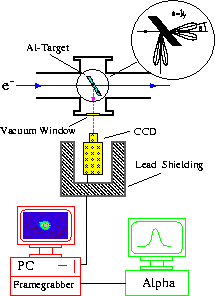
The same setup is used to determine the energy spread of the electron beam in a dispersive section of the beamline. The online determination of the energy spread is an important help in optimizing the rf phases of the cavities.
For operation of the FEL, knowledge of the bunch length, i.e. the peak current is essential. The setup shown in Fig. 4 uses the coherent part of the transition radiation in the far infrared. The radiation passes through a Michelson interferometer consisting of a mylar beamsplitter, one fixed and one movable mirror and is detected in a pyroelectric detector. Analyzing the measured autocorrelation in frequency space taking into account the spectral properties of the setup finally yields a bunch width of 4 ps in a nearly gaussian distribution, which was confirmed by a streak camera measurement using spontaniously emitted ligth from the undulator of the FEL. A detailed description of the setup and the analysis can be found in [9].
To measure the beam current and position without stopping the beam
new rf cavities were developped. The low quality factor (1800 for the current
monitor, 1000 for the position monitor) of these cavities build from stainless
steel 4301 leads to a negligible temperature sensitivity. Once calibrated these
monitors operate without temperature control and need no adjustment. With a
simple setup using frequency modulation a sensitivity of 20 nA for the
current monitor and 0.3 mm/ ![]() A for the position monitor could be achieved.
Presently two monitors are installed, one in the injector and one in the
extraction beamline.
A for the position monitor could be achieved.
Presently two monitors are installed, one in the injector and one in the
extraction beamline.
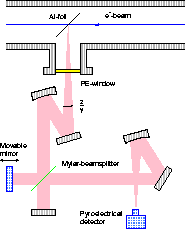
For further increase of the quality factors of the sc cavities, a high
pressure water rinsing system will be installed and will be available in
fall of this year, which will hopefully lead to a Q ![]() =
= ![]() .
The beam transport system will be further optimized which is
expected to result in improved transverse stability and
a reduced energy spread by making use of nonisochronous recirculations.
Beam diagnostics especially the nondestructive monitoring will be installed
in every recirculation and in front of every experimental area.
.
The beam transport system will be further optimized which is
expected to result in improved transverse stability and
a reduced energy spread by making use of nonisochronous recirculations.
Beam diagnostics especially the nondestructive monitoring will be installed
in every recirculation and in front of every experimental area.
It is a pleasure to thank H. Lengeler and H.A. Schwettman for many fruitful discussions and numerous advice. The help of S. Calatroni in the production of the rf couplers is greatfully acknowledged. We are very much indebted to many colleagues at DESY, in particular to A. Matheissen, O. Peters and S. Wolff for their tremendous help and support. We take the opportunity to thank H. Gaiser and the galvanic workshop at GSI, as well as the mechanical workshop at CERN, for their continuing help. For his help in numerical simulations we have to thank T. Weiland.